Root maggots are the destructive enemies of root vegetables and cole crops. Unfortunately, once they are in the home gardens, there is no best remedy to get rid of them except prevention. It is because root maggot control is a crucial practice. And their infestations make the root vegetables inedible and can kill the plant instantly.

Root maggot fly
The root maggot infestation makes the plant susceptible to insects, pests, and microbes. The diseases include root rot and leaf blight. Understanding root maggots’ life cycle and symptom biology will prevent root crops from troublemakers. In addition, these methods will relieve the gardeners from economic damage.
What Are Root Maggots?
Root maggots are the larvae of different species of flies referred to as root maggots. They show resemblance to common houseflies. Root maggot flies are drab gray and named after their host plants. The most common species are cabbage root maggot and onion root maggot. However, these two species also invade other vegetables:

Onion root maggot
1. Root Crops
Onion maggots also attack
- Radish
- Carrots
- Onions
- Turnips
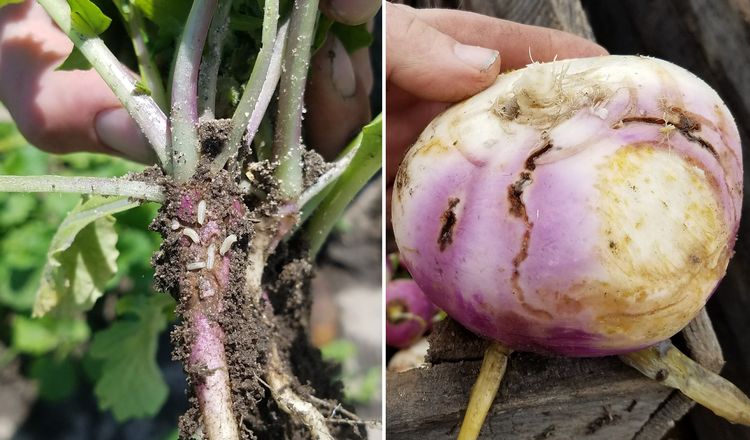
Turnip heavily infested with root maggots.
2. Cole Vegetables
Cabbage maggots infest the following crops
- Cabbage
- Cauliflower
- Kale
- Broccoli
- Mustard
- Collards
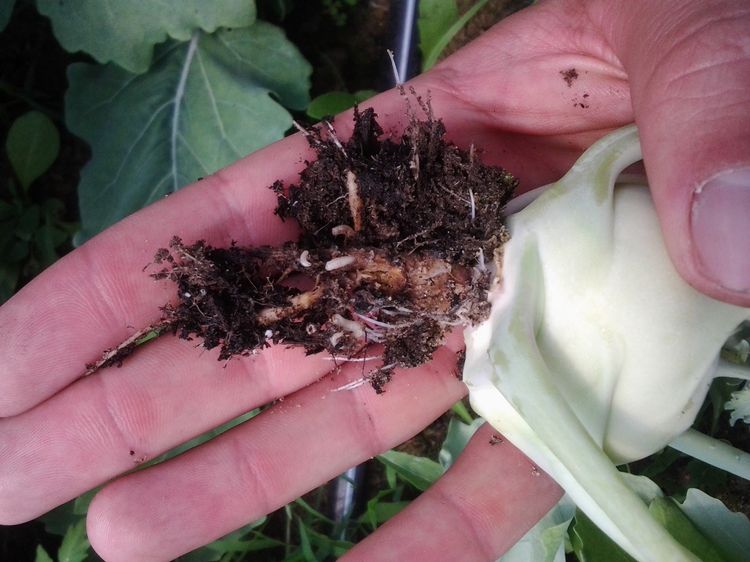
Root maggots are busy feeding on cabbage roots at the early growing stage
Identification of Root Maggots
Adult flies are 0.2 mm in size (smaller than typical houseflies) with dark gray bodies.
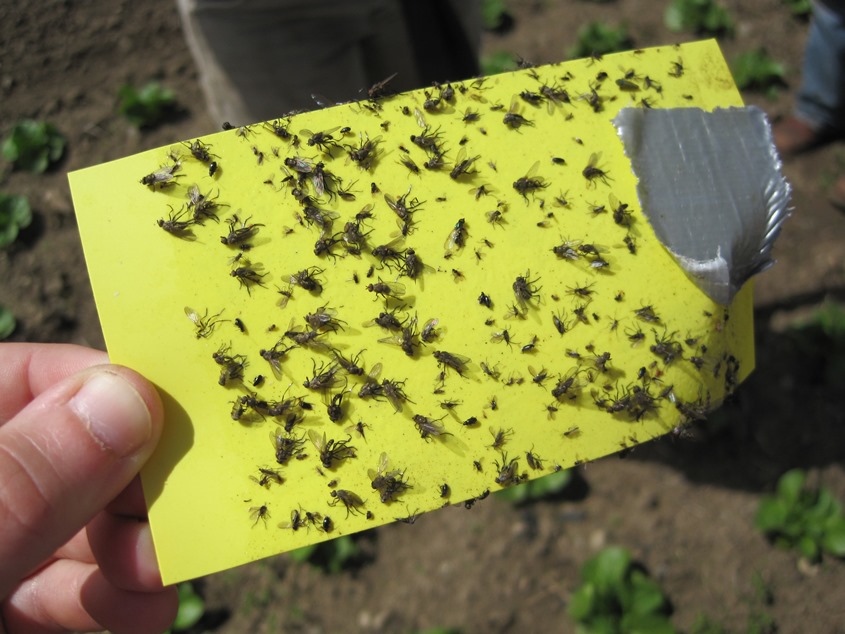
Adult maggot flies are trapped on a sticky card (a practical approach to control adults)
These flies lay their eggs in the soil at the base of their host plants. On the other hand, the larvae are merely 0.25 mm long and are legless.
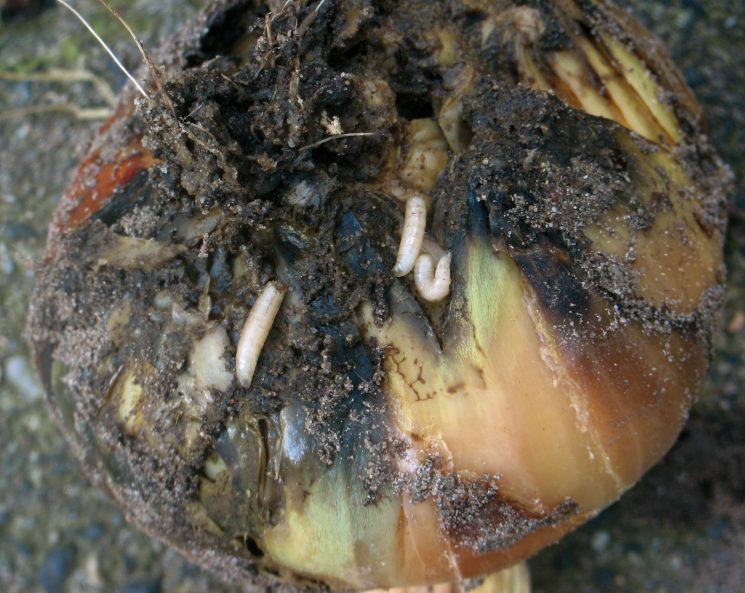
Root maggots and badly infested onion
The larvae are tiny, white with pointed heads and a blunt rear. These root maggots primarily remain underground and voraciously feed on young roots. In heavily infested plants, the root maggot feeding destroys root systems and produces.
The onion maggots, mainly newly hatched larvae, burrow tunnels in newly planted seedbeds in onion crops. Then, they infest the developing bulbs and ultimately damage the below and above-ground parts of onions. The life span of these root maggots is two to three weeks, and then they pupate in the soil.
Damage Caused by Root Maggots
Cabbage maggot or root crop larvae feed on young plants and seedlings. And their infestations destroy crops (roots and cole vegetables). The cabbage root maggot enters the developing bulb and feeds off the roots.
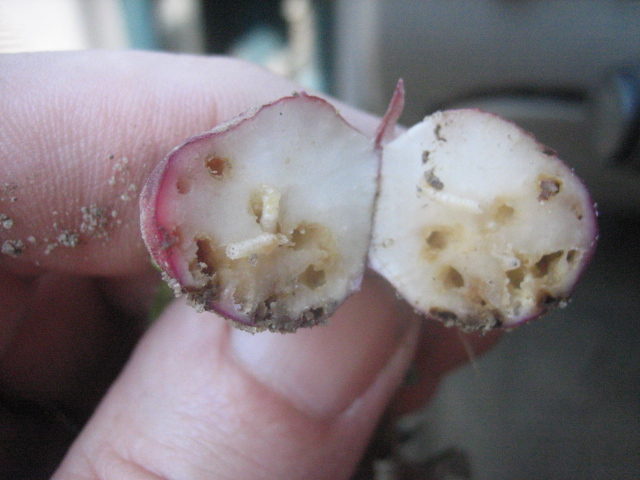
Cabbage maggot infested the radish fruit.
The feeding of root maggots exposes the young seedlings and their roots to other soil-dwelling pests (mealworms and wireworms) and fungal pathogens such as root rot.
On the other hand, the above-ground portion of infested plants becomes wilted and leaves develop brown and black patches. During high numbers of root maggots, the entire plant may collapse on the ground with dead leaves and stems.
The seeds and young plants are more prone to root maggot infestation, and they infest and feed on them throughout the growing season. As a result, they reduce the quality and quantity of yield (the vegetables are inedible). In addition, due to poor quality and health, the vegetables attract rot pathogens.
Note: One of the easiest and quickest ways to identify the root maggots infestations in root crops are:
- Poor health and standing position
- Stunted growth and loss of strength
- Yellowing of foliage followed by blackened stem and leaves due to destruction of the below-ground root system
Related: How to Kill Maggots with Bleach? Know About Various Methods!
Life Cycle Of Root Maggots
The root maggots overwinter as brown pupae in the soil. Then, in early spring plantings, the adults emerge from the ground and cover the distance of one mile to search for their host plants. The female flies lay eggs at the base of the host plant stems.
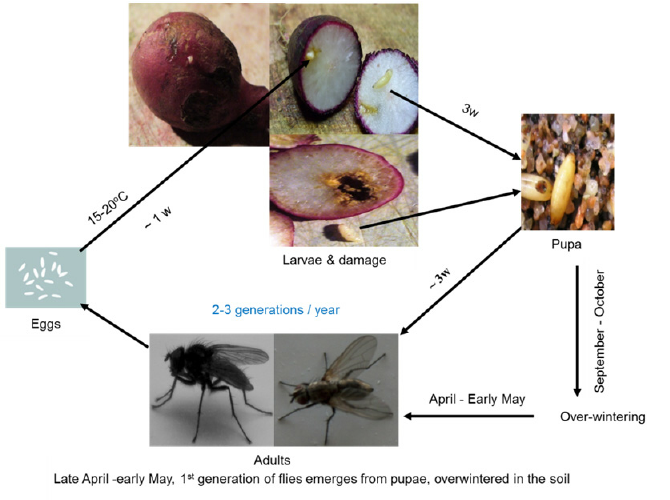
The complete life cycle of root maggots from egg stage to adults
After seven days, root maggot eggs are elongated, white, hatch into white, legless larvae. In the first stage, larvae appear as rice grains burrow down into the soil, searching for cole and root vegetables.
They actively feed on corn seeds (seedcorn maggot), roots of young plants, developing bulbs, and tubers. During feeding, the root maggots undergo three moltings and increase in size. After one to three weeks, the cabbage maggots pupate in the soil or near host plant roots.
These destructive pests have three generations per year (in late spring, early midsummer, and early autumn when weather is favorable). They prefer moist soil and cool temperatures for egg-laying.
And in each cycle, they lay almost 50-200 small eggs in the soil. Even the cabbage root fly makes tunnels in the ground to lay eggs near host plant roots.
How to Get Rid of Root Maggots?
Root maggots are evil enemies of vegetables and home garden owners. Once they invade the vegetable crops, they destroy seedlings and produce, making them inedible. One reason is there are no EPA-approved insecticides to kill root maggots.
The only way to avoid root maggot infestation is (onion and cabbage maggot) prevention. The preventive measures at the right time can prevent plants from damage. Following are the best approaches:
- Do not plant susceptible crops
- If the plant shows any symptom or sign of infestation, simply pull up the entire plant and examine roots or root hairs. If you suspect root maggots infestation, discard the whole plant to block further spread.
- Establish the sticky traps at different sites in the whole garden and near seedbeds to distract the adult flies from laying eggs.
The other best approach to control root maggots are:
Organic Root Maggot Control
The organic or natural maggot control approach involves various techniques and measures to control cabbage maggots infestations. And these are:
Crop Rotation
Crop rotation is an essential approach to prevent crops from cabbage root fly. This approach involves planting non-host crops on the same site to avoid the infestation of root maggots. In addition, this practice will prevent the produce from overwintering larvae and their damage.
Note: Plant the host vegetable crops far away from the previous year’s location because the adult flies cover a distance of one mile in search of host seedlings.
Floating Row Covers
Floating row covers are polyester or polypropylene material used to protect crops such as brussels sprouts, onions, cabbage, radish, carrots, cauliflower etc. These covers protect crops from garden pests (cabbage fly, onion root fly, caterpillars, turnip flies, rove beetles, seedcorn maggot, onion maggot, thrips, whiteflies, and aphids).
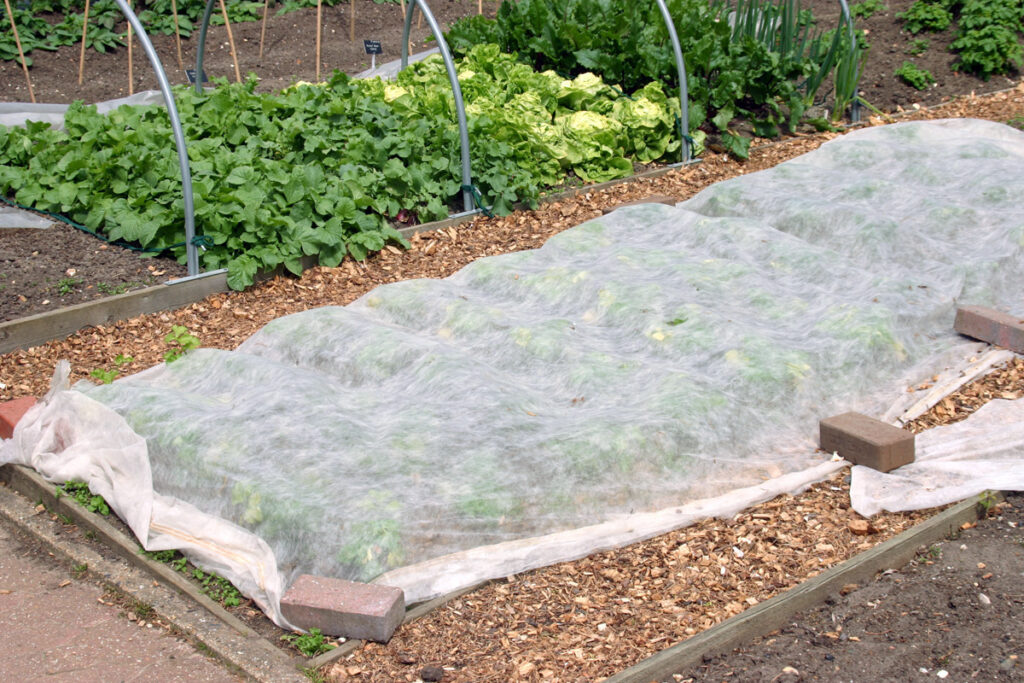
Floating row covers to prevent the crop of radish in the home garden
Floating row covers are placed or put on plantings to prevent the infestations of adult flies. After emerging from overwintering sites, these flies fly long distances, searching for host plants. While covering crops with polyester sheets, ensure the area is not already infested with root maggots.
The polyester sheets also prevent moisture loss, nutrients, and beneficial microbes. These covering also prevent plants from heat stress.
Diatomaceous Earth
Apply diatomaceous earth around the base of the young seedlings and seed beds with new transplants. It will discourage the root maggots from feeding on young roots and seeds.
Always reapply the diatomaceous earth after rain and every watering to refresh the control measures.
Adjust Planting Time to Avoid the Root Maggots Feeding
The root maggots infestation can be avoided by adjusting the planting schedule. For example, delaying the planting of vegetables till May and early June will kill the eggs (prevent the hatching and larvae damage). The scorching sun of June will prevent the eggs hatch.
Use Pyrethrin Drench to Prevent Root Maggots Infestation
The mixing of pyrethrin in garden soil as a drench will kill the eggs of adult flies. This approach is practical to control root maggots.
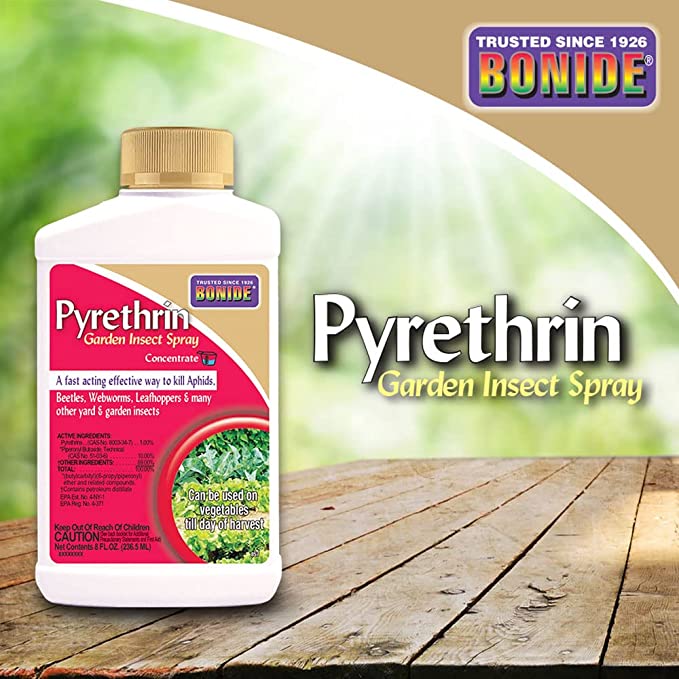
Pyrethrin spray to kill root maggots
Use Biocontrol Agents to Prevent Cabbage Root Maggot Infestation
There are many natural enemies of cabbage fly and their larvae. These are parasitic wasps, predatory mites, and carabid beetles. These parasites feed on egg-laying adult flies, their eggs, and larvae.
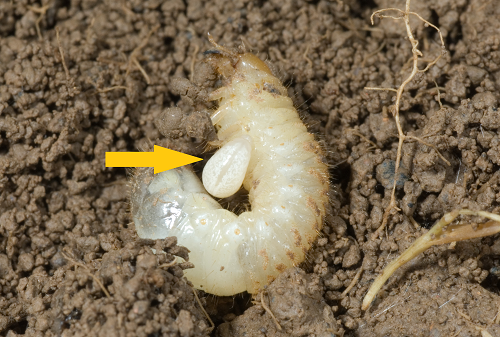
The larvae of predaceous mite munching on cabbage fly maggots
Moreover, the beneficial nematodes and fungi also infect and destroy the grubs.
Sanitation of Garden
Thoroughly clean and maintain the garden and indoor spaces to prevent the infestation of adult flies and other pests. This practice will act as the first line of defense from seedcorn maggot damage.
Remove the dead, fallen leaves, and infected dying plants from the garden ground and discard them properly. The sanitary practices will help in the prevention of potential infestations.
Frequently Asked Questions
Will Sevin Kill Root Maggots?
The Sevin products contain carbaryl—a broad-spectrum insecticide that effectively kills underground larvae. It is available as a powder sprinkled on plants and infested soil. It can also be applied as a soil drench for effective root maggot control.
How Do You Kill Maggots in the Garden?
There is no certified or approved chemical control against maggots of essential vegetables. However, the only best way to control grubs is prevention, and it includes:
- Adjusting planting schedule
- Proper sanitary conditions
- Crop rotation
- Covering of vegetables at an early stage of seedling
- Use diatomaceous earth around the base near host plants
- Application of beneficial nematodes
What Are the Signs of Root Maggot Infestations?
The first sign of root maggot infestations is the presence of adult flies around the base of host plants. The second clue of their existence is the loss of plant vigor due to root system destruction.
To confirm the infestation of maggots, simply pull off the suspected plant and carefully examine its root.
How Do You Prevent Root Maggots in Onions?
The biological control agents will prevent the crop from onion maggots such as soil-living fungi, nematodes, and predatory beetles. These parasitic agents feed on eggs, larvae, pupae, and adults.
How Do I Get Rid of Maggots in My Potted Plants?
The cabbage fly and its larvae feed on roots and cole crops. They happily infest and destroy below-ground roots, tubers, bulbs, and other plants. If your potted plant is infested, the best you can do is remove it from the pot and discard it because there is no chemical control available for maggots.
The best you can do is to employ preventive measures. These measures will help in the control of larvae. For example, maintain cleanliness apply diatomaceous earth as a drenching potting mix. The other best practice is using mesh coverings.
Sources For Further Reading
- Hassani, N. (2022, February 25). How to Control Root Maggots in the Garden. The Spruce. Retrieved March 13, 2022, from https://www.thespruce.com/root-maggots-5216356
- Onion Maggot. (2017, May 11). Center for Agriculture, Food, and the Environment. Retrieved March 13, 2022, from https://ag.umass.edu/vegetable/fact-sheets/onion-maggot
- Mahr, S. (n.d.). Floating Row Cover. Wisconsin Horticulture. Retrieved March 13, 2022, from https://hort.extension.wisc.edu/articles/floating-row-cover/
- Mercer, N. (2020, August). Insect Parasitoids: Important Natural Enemies of Pests | Entomology. ENTOMOLOGYat the University of Kentucky. Retrieved March 13, 2022, from https://entomology.ca.uky.edu/018
Now that you know how to control root maggots, check out our other articles about plant bugs:
Identification and Control of Darkling Beetles by Natural and Chemical Ways
An All-In-One Guide to Small Brown Bugs | Fun Facts, Pictures and Identification Guide
Types of Green Caterpillars with Fun Facts, Stunning Pictures and Loads More!!!







